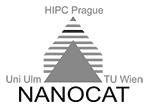Membrane Fusion at the Nanoscale
Membrane fusion is a key process in all living cells. It facilitates the transport of molecules between and within cells, the exchange of contents between various membrane-enclosed compartments in eukaryotic cells and communication across membranes. Efficient and controllable fusion of biological membranes is known to be driven by cooperative action of SNARE proteins, the central components of the eukaryotic fusion machinery responsible for fusion of synaptic vesicles. Recently, inspired by SNARE proteins, a simplified model system for membrane fusion based on two complementary lipopeptides and has been developed. This work aims at elucidating in detail the mechanism by which fusion progresses at the molecular lever and identifying the most efficient fusogenic lipopeptides that could potentially be used for in-vivo applications.
doc. RNDr. Šachl Radek Ph.D.
 jh-inst.cas.cz
jh-inst.cas.cz

















